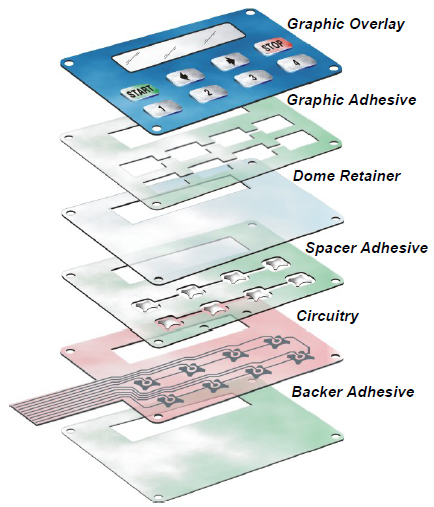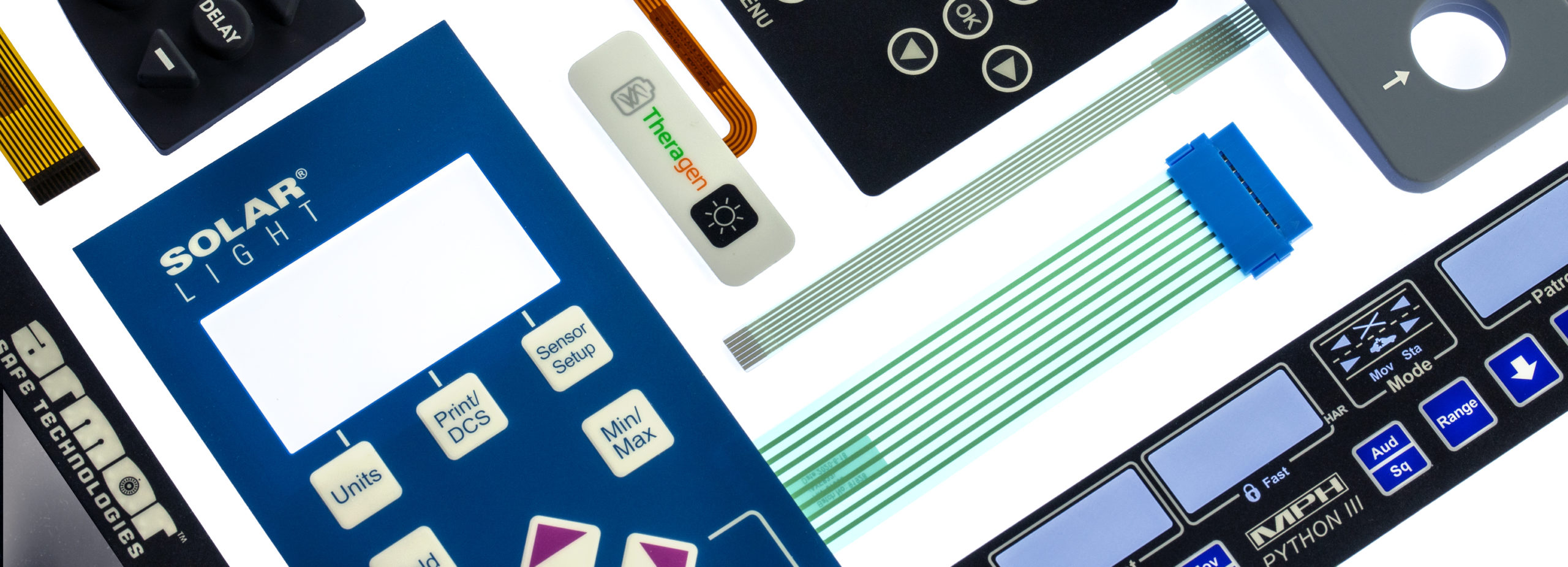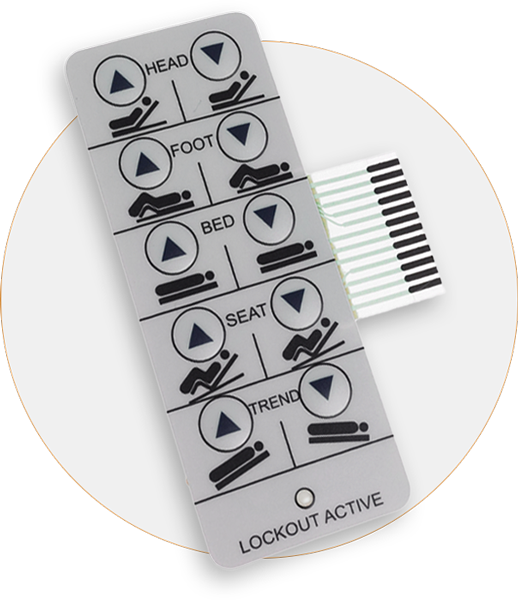Top companies often choose a skilled membrane switch manufacturer to deliver high-quality results.
Top companies often choose a skilled membrane switch manufacturer to deliver high-quality results.
Blog Article
Everything About Membrane Layer Change: Understanding Its Layout and Capability
When you assume concerning the control interfaces in modern-day devices, membrane layer buttons usually come to mind. Allow's explore what sets membrane changes apart from various other control systems.
What Are Membrane Switches?

Membrane switches can also be personalized concerning shape, size, and graphics, permitting manufacturers to develop special interfaces tailored to specific products. In general, membrane layer switches play a considerable role in improving individual experience across a vast variety of applications.
Exactly How Membrane Layer Switches Over Work
When you press a trick on a membrane layer switch, it turns on a simple yet effective system. membrane switch manufacturer. The leading layer, typically made of versatile material, presses down onto a conductive layer below it.
You'll observe that the tactile responses varies based on the button design, offering either a soft click or a much more obvious reaction. As soon as you launch the key, the membrane returns to its initial position, resuming the circuit and quiting the signal. This procedure takes place virtually instantly, making sure a responsive user experience.
Membrane layer switches are preferred due to their sturdiness and resistance to dirt and wetness, making them suitable for different applications, from household home appliances to medical devices. Recognizing this procedure helps you appreciate their extensive usage.
Secret Components of Membrane Layer Switches
Understanding the vital parts of membrane buttons is basic for understanding their capability and design. The safety layer guards against ecological variables and wear, expanding the switch's life-span. By understanding these components, you'll obtain understanding right into how membrane switches over operate and their relevance in different applications.
Products Utilized in Membrane Layer Change Style
The efficiency and resilience of membrane switches over greatly depend on the products used in their design. You usually come across polyester and polycarbonate as main substratums as a result of their outstanding strength and flexibility. These products resist scratches and chemicals, making them excellent for requiring atmospheres.
The conductive layers usually make use of silver or carbon, chosen for their integrity and conductivity. membrane switch manufacturer. Silver provides remarkable efficiency, while carbon is an affordable choice. For the overlay, you might take into consideration a matte or glossy surface, relying on your aesthetic demands and individual experience
Make certain to choose adhesives that endure environmental aspects like temperature and humidity. Selecting the ideal materials will certainly guarantee your membrane layer switch stands the examination of time.
Layout Considerations for Membrane Buttons
While developing membrane switches, it's important to take right into account various aspects that affect their performance and individual experience. Start by concentrating on the design and button size; make sure they're instinctive and very easy to navigate. Take into consideration the tactile feedback you want to give-- will users need a visible click or a softer touch? Furthermore, consider the products you'll use, as they'll affect durability and appearances.
Don't forget the visuals style; clear labeling and shade contrast are significant for visibility. Confirm your layout suits ecological elements, like moisture or temperature variants, which can impact performance. Finally, keep in mind the relevance of testing prototypes with actual individuals to gather responses and make required changes. This iterative process helps you refine the style, confirming it satisfies both practical and visual needs efficiently. By carefully thinking about these components, you'll produce a membrane layer button that improves use and satisfaction.
Applications of Membrane Switches
Membrane layer buttons are versatile elements discovered in different applications, from commercial devices to customer electronics. You'll see their influence in equipments that require durable user interfaces and in devices that take advantage of streamlined designs. Comprehending these applications assists you appreciate the capability and practicality of membrane layer switches in everyday modern technology.
Industrial Tools Use
When you're aiming to boost the functionality of industrial equipment, membrane buttons offer a reputable solution that combines resilience with easy to use layout. These buttons are perfect for harsh atmospheres, offering resistance to dust, moisture, and chemicals. You'll discover them in control panels for producing devices, HVAC systems, and clinical gadgets, where accuracy and responsiveness are essential. Their reduced account means they fit effortlessly right into different equipment, conserving valuable area while maintaining convenience of usage. With customizable graphics and backlighting alternatives, you can develop an intuitive interface for operators, boosting efficiency and safety and security. And also, their long life expectancy reduces maintenance costs, making them a clever investment for your industrial applications. Accept membrane layer switches to enhance your operations and improve general efficiency.
Customer Electronics Combination
In the domain name of customer electronic devices, membrane layer switches play a vital function in improving individual recommended you read communication and gadget performance. Membrane layer buttons also ensure longevity and resistance to dirt and wetness, extending the life-span of your electronics. By selecting membrane buttons, you enhance not simply the capability however likewise the design of your tools, making daily interactions smooth and pleasurable.
Advantages and Disadvantages of Membrane Layer Buttons
While membrane layer switches use a variety of benefits, they additionally come with some drawbacks that you should think about. One considerable advantage is their compact layout, making them perfect for space-constrained applications. They're likewise economical, giving a durable solution with a reduced manufacturing expense. Additionally, their smooth surface area is simple to tidy, boosting health in settings like medical facilities.

Membrane layer buttons can have a shorter life expectancy contrasted to mechanical switches, specifically under heavy usage. They can also be much less responsive, which could impact user feedback during operation. Stabilizing these pros and cons will certainly help you figure out if membrane layer buttons are the best fit for your project.
Often Asked Concerns
The Length Of Time Do Membrane Layer Switches Typically Last?
Membrane changes normally last in between 5 to 10 years, relying on use and ecological problems. You'll desire to evaluate elements like check my site wear, direct exposure to dampness, and temperature level changes to evaluate their durability efficiently.
Can Membrane Layer Changes Be Customized for Details Designs?
Yes, you can customize membrane layer switches to fit particular layouts (membrane switch manufacturer). You'll have the liberty to select colors, shapes, and layouts that match your job's look at here needs, ensuring they mix perfectly with your overall visual
What Is the Cost Range for Membrane Switch Production?
The cost array for membrane layer button production usually falls in between $1 and $10 each, relying on aspects like design complexity, amount, and materials. You can obtain quotes from producers to find the best option.

Are Membrane Switches Over Water-proof or Resistant?
Membrane switches can be made to be waterproof or resistant, depending upon products made use of and construction approaches. If you need them for wet atmospheres, guarantee you specify those needs during the design process.
How Do Membrane Layer Switches Compare to Conventional Switches?
Membrane buttons are usually thinner and a lot more flexible than standard switches, using a smooth style. They're commonly simpler to clean up and integrate, but may not offer the tactile responses you're used to with mechanical choices.
Verdict

Report this page